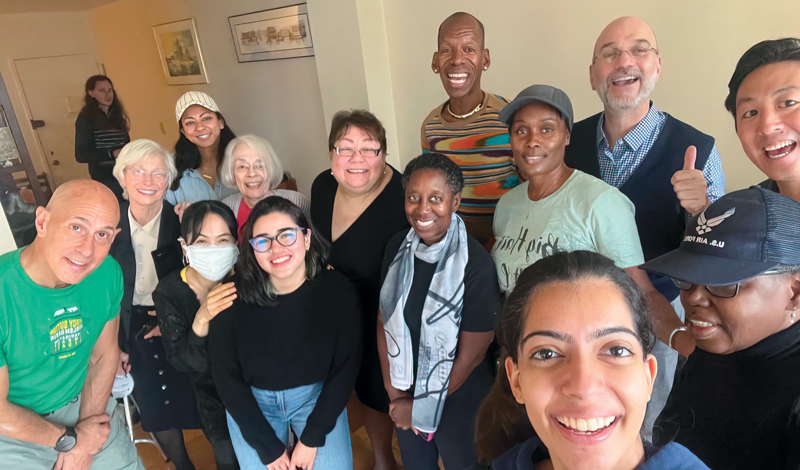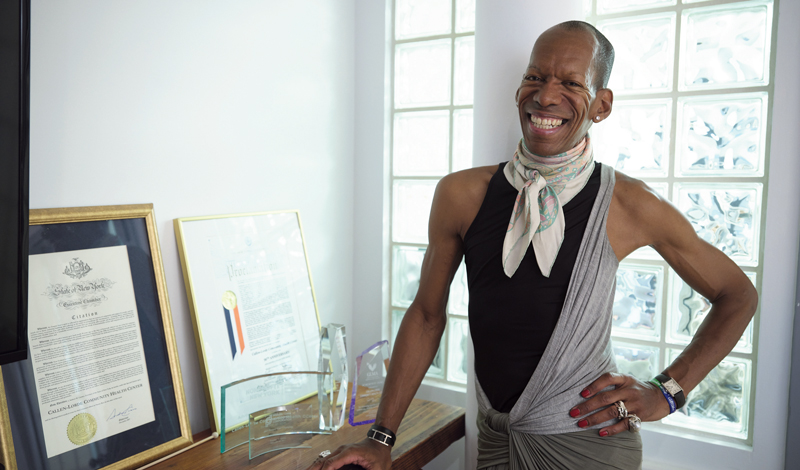Living Buddhism: You left home at 17 to make a life for yourself in New York. What drew you at such a young age from Charleston, South Carolina, to the Big Apple?
Blane Charles: In fact, I was drawn back—I was born in Brooklyn. My family moved to Charleston when I was 10. New York for me has always been home. As a young person,
I saw it as the place I could discover, or rediscover, myself—the self that had been shunned and buried underground. There simply wasn’t anything for me at home in Charleston. I’d have left earlier if I could have. Raised in a hardline, isolationist religious community, there were parts of me that were not welcome.
At 13, I came out as gay to my parents and the elders of my religious community and was, to use their word—excommunicated, though shunned might be a better word. I was not forced to leave, but suddenly, no one spoke to me. Overnight, friends, family—everyone—turned their backs to me. I was invisible. While others gathered for communal meals, I ate alone in my room. This was the official policy of the elders. I could reenter the fold of community life but only if I recanted what I’d said about myself. But what I’d said was the truth; I couldn’t recant who I was.
Part of me wanted to, though. Soon after the elders declared my excommunication, I attempted suicide. Luckily, I lived on, long enough to make it to high school. Public high school exposed me to a wider array of perspectives than I’d ever encountered. School became my escape, the place where I could thrive. I stayed there as long as I could, in after-school programs, extracurriculars, sports, writing contests—everything and anything. But at some point, I’d always return home to silence, shame and invisibility.
As soon as I was able to, I left. At 17, I moved back to New York, to make there whatever life I could.
Simply moving to New York, however, was not the silver bullet to my suffering I’d expected it to be. I’d left a stifling existence behind in Charleston, but I hadn’t left behind my suffering. What’s more, there was plenty of suffering to be found in the city.
In New York, I chased drugs, parties, and fashion—anything that might offer even temporary relief from what was, by all measures, a suicidal existence. I did not care if I died, and I lived that way. In 1981, a little over a year after arriving in New York, I made another attempt on my life. I was saved by a health care provider serving the needs of New York’s LGBTQ+ population. Again, I survived. For me, it was a wake-up call; I sensed for the first time that I might be alive for a reason.
You lived long enough to meet Buddhism.
Blane: Yes—I met Calvin and Liz-Anne while I was working at an ice cream parlor. Every time they came in, they were radiant, glowing.
What are they on? I’d wonder. The only thing I could think of that might make people feel as good as they seemed to feel was a pill—some kind of drug. One day, when I was feeling particularly crappy (I think I’d just been dumped), I simply couldn’t keep the question to myself. I asked them, “What are you two on?” That’s when they told me they were Nichiren Buddhists. They chanted Nam-myoho-renge-kyo, and I was welcome to come over sometime to give it a try.
I was at rock bottom. They were bright, vibrant, and I just grabbed ahold of them like: Pull me out of this muck!
We got into a rhythm. I’d wake up around 6:30 and catch the train to them. We’d chant an hour and then study Buddhism over coffee.
Do you remember anything in particular that struck you in your morning studies?
Blane: I do. It was a little over a month into our morning routine when we sat down to study a Buddhist concept I’d never heard of called “voluntarily assuming the appropriate karma” or “changing karma into mission.”
According to these principles, everything I’d been through, I’d been through for a reason. And the reason was that I’d made a promise—a vow, rather—in the infinitely remote past, to take on all these hardships. Why the hell would I have done that? I remember thinking. But as we read on, I came to grasp the reason for that as well: I’d taken on these challenges in order to overcome them—to demonstrate to innumerable others that there is no karma that cannot be overcome, no hardship that cannot be transformed into a source of immense value.
Now that turned my worldview upside down. I was not a victim—I was the protagonist of the life I had willingly chosen for myself, with a mission to transform my karma for my own happiness and that of others. Had someone told me this a month earlier, I think I’d have gotten into a brawl with them. But having been chanting daily, my heart was open; I was able to fully embrace and celebrate this idea.
I’d made a promise—a vow, rather—in the infinitely remote past, to take on all these hardships. I pursued and secured work in which I was highly visible, in which the parts of myself that had been shunned were celebrated.
Tell us a little more about your work in fashion and why it’s so important to you.
Blane: Sure. Remember, these were the ’80s, a decade that saw the AIDS epidemic sweep the country, taking the lives of over 100,000 Americans. Among them were my friends and partners. To lose so many loved ones was unspeakably painful. My friends died in isolation from all but their immediate families, ashamed of having lost their physical strength and beauty, ashamed of what was happening to them.
Fashion, which I had once used to mask my pain with an outward show of glamour, became a way to impart the sense of joy and pride I was cultivating within my life. In a community experiencing heightened levels of trauma, I also witnessed a divisiveness. But my Buddha wisdom helped bring everyone together. I was able to respect and unite a diverse group of highly opinionated people. I began taking center stage in other areas of my life as well, becoming increasingly involved in runways and fashion shows aimed at sending messages of empowerment and pride to the marginalized LGBTQ+ community. I involved myself in organizing with movements, which drew attention to the plight of the queer community and demanded actions to safeguard the dignity of the lives of its members.
How did your efforts develop from there?
Blane: From 1990 to 2000, I traveled Europe as a model and a dancer, chanting all the while. It was a deeply healing experience for me. At the turn of the decade, however, I could no longer ignore an inner voice that had been growing in volume. It said: So, you’ve been healing. That’s wonderful, but what are you going to do? I had a growing sense that healing any further would not take place in Europe, far away from home.
I made it back to New York just in time for the Pride Parade. I have to say I was astonished to see SGI members show up in force to march with their own float. To me, it felt like a true homecoming, the one I’d been looking for when I first came back to New York, at 17. For the first time, I dove headfirst into SGI activities. As it happened, my apartment was just two blocks away from the SGI-USA New York Culture Center. I made that apartment a castle of kosen-rufu, hosting SGI activities there regularly.
By which you mean raising people up out of their suffering and into empowerment!
Blane: Yes! I felt then as I do now, that young people deserve to know about Ikeda Sensei, deserve to know about a non-bureaucratic, open and nurturing religious movement striving to embrace and uplift everyone without exception. I want others to experience what it feels like to be motivated not by shame or guilt but by a wonderful teacher and teaching, by positive, like-minded friends.
You mentioned “changing karma into mission.” What’s another Buddhist concept that has resonated with you?
Blane: One that I learned at the outset of my practice is less of a concept and more of a mentality. It’s called “making the impossible possible.” One thing that I felt was certainly impossible was reuniting with my family back in Charleston. The ruling by the elders still held; I was not to be engaged with in any way until I recanted who I was. For so much of my life, I blamed my family for the pain that I’d experienced during and after childhood. So, I began a sustained campaign to chant for my family’s happiness.
In 2006, my mother reached out to me, wanting to reconnect. Had I not been chanting so intensively for her happiness, I might have turned it down. I chose to reconnect, and it was an incredible experience. I was able to let go of much of the hurt I’d grown up with.
That same year, I launched my own personal business, which focuses on interior design and fashion. In the work I do, I’ve found what an underrated skill listening is. I had one client whose mother had recently passed away. She’d gained weight and was struggling to keep her house. She didn’t feel good about herself or her life at all. It was 20 years ago when we first met, and she’s still with me today. The reason, she says, is that I celebrated her and made her feel good at the point of life she was at when we met.

Amazing! How are things today?
Blane: Today, fashion is not something I use to mask my pain but something I use to fortify myself and others.
And this year alone, I’ve planted over 2,000 seeds (meaning telling people about Nam-myoho-renge-kyo)! “What is your dream?” I like to ask people. Then, I’ll often write down what they share on a slip of paper. “I’ll keep this and chant for you to realize this dream,” I tell them.
In 2019, I was asked to join the board of an organization, which provides sensitive, quality health care and related services targeted to New York’s LGBTQ+ communities. At first, it took me aback. Who, me? But that thought, I realized, was born out of an internalized voice of self-doubt. Yes, me—why not me? says my Buddha nature.
Years ago, there was one young man I remember in particular, perhaps because he reminded me so much of myself. He, too, was gay, and he, too, had been shunned by his family. We’d chant together, support activities together, study together. He was like my little brother. Together with other compassionate friends in faith, we raised him up.
There’s no judgment in this practice—all of us are doing our human revolution at our own pace. Because there’s no judgment, people are more determined to be a better version of themselves every day. Instead of being controlled by guilt, anger or shame, each person is inwardly motivated by a spirit of self-challenge. Helping another person—walking alongside them as they do their human revolution and awaken to their mission—is a deeply gratifying experience for me. This is what it means, I realized, to change karma into mission. I take that same spirit into all the work that I do with others—in interior design, in fashion, in the SGI, in everything.
You are reading {{ meterCount }} of {{ meterMax }} free premium articles

